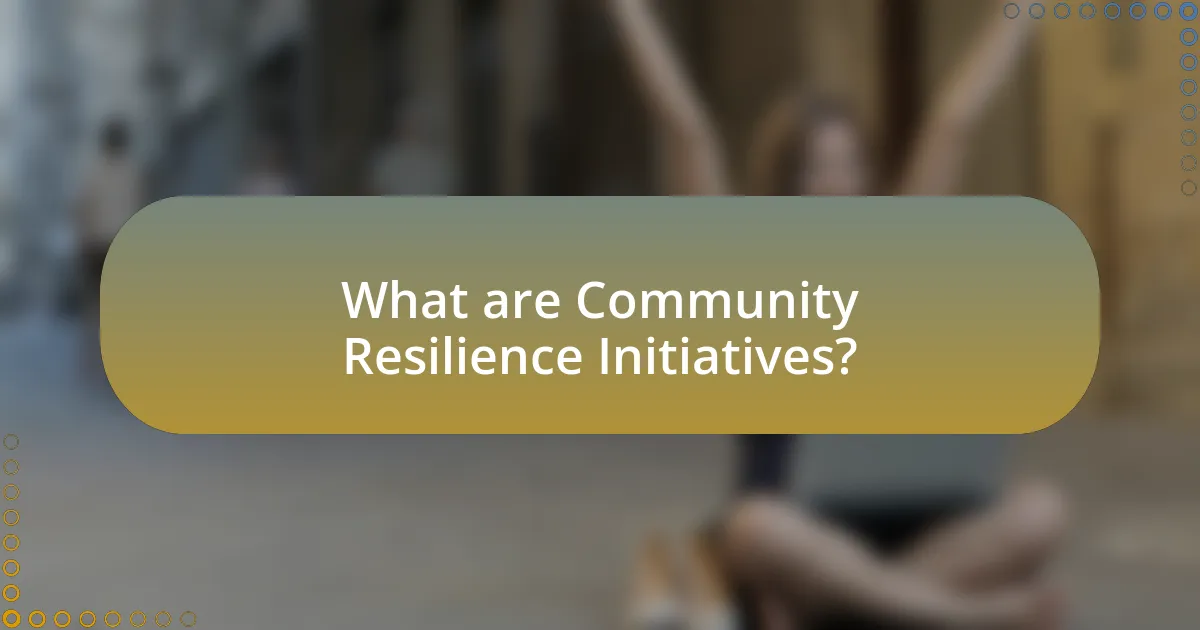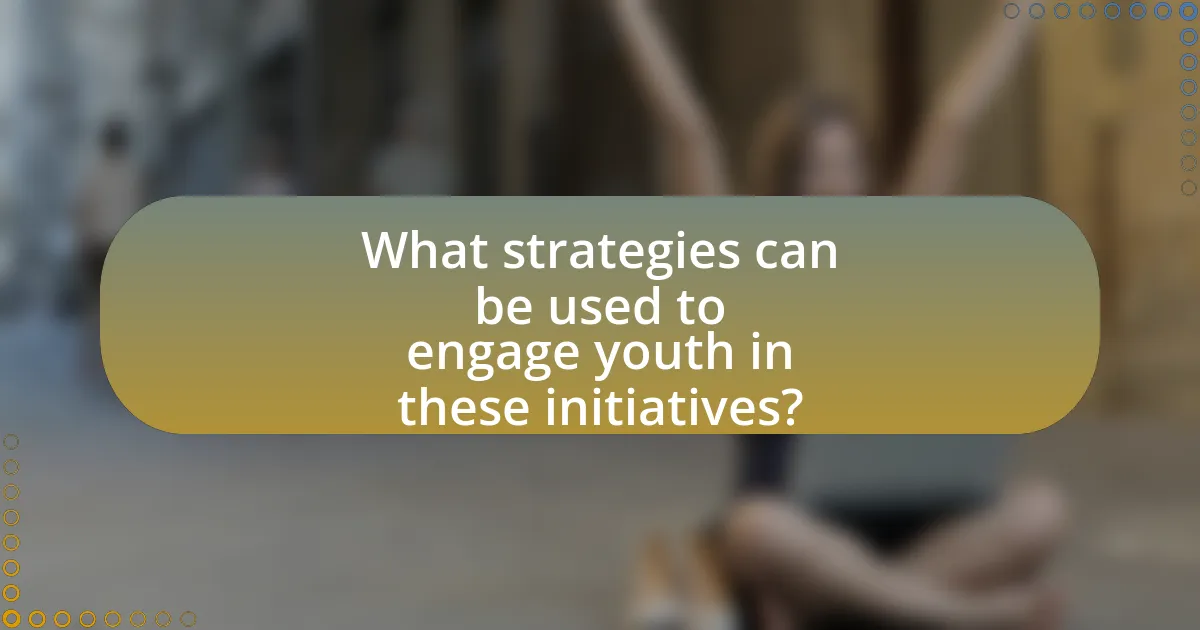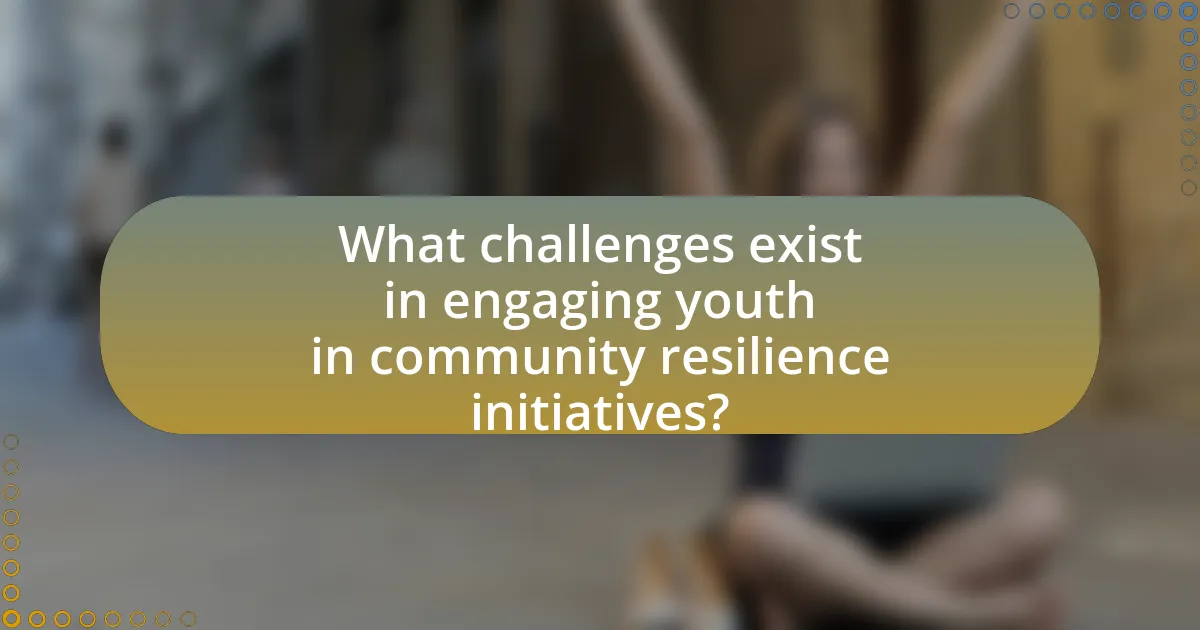Community Resilience Initiatives are structured efforts designed to strengthen the capacity of communities to endure and recover from adverse events, such as natural disasters and economic challenges. This article explores the significant role of youth engagement in these initiatives, highlighting how young people contribute to community development, enhance social cohesion, and improve problem-solving capabilities. It discusses the impact of youth involvement on community resilience, the unique perspectives they bring, and the strategies that can effectively engage them, including the use of technology and experiential learning. Additionally, the article addresses the challenges faced in youth participation and outlines best practices for sustaining their involvement in community resilience efforts.

What are Community Resilience Initiatives?
Community Resilience Initiatives are organized efforts aimed at enhancing the ability of communities to withstand and recover from adverse events, such as natural disasters or economic downturns. These initiatives often involve collaboration among local stakeholders, including government agencies, non-profits, and community members, to develop strategies that improve social cohesion, resource management, and preparedness. For example, a study by the National Academies of Sciences, Engineering, and Medicine highlights that communities with strong resilience initiatives can reduce recovery time and costs associated with disasters, demonstrating the effectiveness of such programs in fostering community strength and adaptability.
How do Community Resilience Initiatives impact youth engagement?
Community resilience initiatives significantly enhance youth engagement by providing opportunities for active participation in local decision-making processes. These initiatives empower young people to contribute to community development, fostering a sense of ownership and responsibility. Research indicates that youth involved in such programs report increased civic knowledge and skills, which are crucial for effective engagement. For instance, a study by the National League of Cities found that youth participation in community resilience projects leads to improved social connections and a greater likelihood of continued civic involvement in adulthood.
What roles do youth play in Community Resilience Initiatives?
Youth play critical roles in Community Resilience Initiatives by acting as catalysts for change, leaders in advocacy, and innovators in problem-solving. They engage in community planning, contribute fresh perspectives, and mobilize peers to participate in resilience-building activities. For instance, studies show that youth involvement in disaster preparedness programs enhances community response capabilities, as evidenced by the Youth Preparedness Council’s initiatives in the United States, which have successfully increased local engagement and awareness. Additionally, youth often leverage technology and social media to disseminate information and foster community connections, further strengthening resilience efforts.
How can youth influence the effectiveness of these initiatives?
Youth can influence the effectiveness of community resilience initiatives by actively participating in decision-making processes and bringing innovative ideas that resonate with their peers. Their involvement can lead to more relevant and impactful solutions, as young people often have unique perspectives on community needs and challenges. For instance, research from the United Nations indicates that youth engagement in local governance can enhance the responsiveness of initiatives, as seen in programs like the Youth Empowerment Program in Kenya, which resulted in increased community participation and improved outcomes. By leveraging social media and technology, youth can also mobilize support and raise awareness, further amplifying the initiatives’ reach and effectiveness.
Why is youth engagement crucial for community resilience?
Youth engagement is crucial for community resilience because it fosters innovation, strengthens social networks, and enhances problem-solving capabilities. Engaged youth bring fresh perspectives and energy, which can lead to creative solutions for local challenges. Research indicates that communities with active youth participation are better equipped to adapt to changes and recover from crises, as they leverage the diverse skills and ideas of younger generations. For instance, a study by the National League of Cities found that cities with youth engagement initiatives reported improved community cohesion and increased civic participation, demonstrating the tangible benefits of involving youth in resilience efforts.
What unique perspectives do youth bring to community resilience?
Youth bring innovative ideas and fresh perspectives to community resilience by leveraging their familiarity with technology and social media. Their ability to communicate and mobilize quickly through digital platforms allows for rapid dissemination of information and engagement in community initiatives. For instance, studies show that youth-led movements, such as climate strikes, have significantly influenced public policy and community awareness, demonstrating their capacity to drive change. Additionally, their unique experiences and viewpoints can challenge traditional approaches, fostering inclusivity and adaptability in resilience strategies. This generational insight is crucial for addressing contemporary challenges effectively.
How does engaging youth enhance community problem-solving?
Engaging youth enhances community problem-solving by leveraging their unique perspectives and innovative ideas. Youth often bring fresh insights and a willingness to challenge the status quo, which can lead to creative solutions for local issues. For instance, a study by the National League of Cities found that youth involvement in community projects increases the likelihood of successful outcomes, as their engagement fosters collaboration and diverse viewpoints. This collaborative approach not only empowers young individuals but also strengthens community ties, ultimately leading to more effective and sustainable problem-solving strategies.

What strategies can be used to engage youth in these initiatives?
To engage youth in community resilience initiatives, organizations can implement interactive and participatory programs that foster collaboration and creativity. For instance, utilizing technology such as social media campaigns and mobile applications can effectively capture the attention of young people, allowing them to share their ideas and experiences. Research indicates that youth are more likely to participate when they feel their contributions are valued; thus, creating platforms for youth-led projects can enhance their investment in these initiatives. Additionally, partnerships with schools and local youth organizations can facilitate outreach and provide structured opportunities for involvement, as evidenced by successful programs that have increased youth engagement by over 30% in similar contexts.
How can educational programs foster youth involvement?
Educational programs can foster youth involvement by providing hands-on learning experiences that encourage active participation in community initiatives. These programs often incorporate project-based learning, where students engage in real-world problems, enhancing their sense of agency and responsibility. For instance, research from the National Youth Leadership Council indicates that service-learning programs significantly increase youth engagement by allowing them to apply academic skills in community service contexts, thus promoting civic responsibility and leadership skills.
What types of educational programs are most effective?
Experiential learning programs are among the most effective educational programs for engaging youth in community resilience initiatives. These programs actively involve participants in hands-on experiences that foster critical thinking, problem-solving, and collaboration. Research indicates that experiential learning enhances retention of knowledge and skills, as evidenced by a study published in the Journal of Experiential Education, which found that students participating in experiential learning scored significantly higher on assessments compared to those in traditional lecture-based settings. Additionally, programs that incorporate community service and project-based learning have been shown to increase youth engagement and civic responsibility, further supporting their effectiveness in building community resilience.
How can experiential learning opportunities be integrated?
Experiential learning opportunities can be integrated by incorporating hands-on activities, community projects, and real-world problem-solving into educational curricula. This approach allows students to apply theoretical knowledge in practical settings, enhancing their understanding and retention of concepts. For instance, programs that involve youth in local environmental initiatives not only teach ecological principles but also foster a sense of responsibility and community engagement. Research indicates that experiential learning significantly improves critical thinking and collaboration skills, as evidenced by a study published in the Journal of Experiential Education, which found that students participating in experiential learning programs demonstrated higher levels of engagement and achievement compared to traditional learning methods.
What role does technology play in engaging youth?
Technology plays a crucial role in engaging youth by providing platforms for communication, collaboration, and participation in community resilience initiatives. Digital tools such as social media, mobile applications, and online forums facilitate real-time interaction and information sharing among young people, enabling them to connect with peers and community leaders. For instance, a study by the Pew Research Center found that 95% of teens have access to a smartphone, which they use to engage with social issues and mobilize for community action. This accessibility empowers youth to voice their opinions, organize events, and participate in decision-making processes, thereby enhancing their involvement in community resilience efforts.
How can social media be leveraged for community resilience?
Social media can be leveraged for community resilience by facilitating communication, fostering collaboration, and disseminating information during crises. Platforms like Twitter and Facebook enable real-time updates and alerts, allowing communities to respond quickly to emergencies. For instance, during natural disasters, social media has been used to coordinate volunteer efforts and share resources, as seen in the response to Hurricane Harvey in 2017, where local organizations utilized social media to mobilize support and provide critical information. Additionally, social media can engage youth by creating spaces for dialogue and participation in resilience initiatives, empowering them to contribute to community planning and response efforts.
What digital tools can facilitate youth participation?
Digital tools that can facilitate youth participation include social media platforms, mobile applications, and online collaboration tools. Social media platforms like Instagram and Twitter enable youth to share their opinions and engage in discussions, fostering a sense of community and activism. Mobile applications, such as those designed for civic engagement, allow young people to participate in surveys, polls, and community projects directly from their smartphones. Online collaboration tools, like Google Workspace and Slack, provide spaces for youth to work together on initiatives, share resources, and communicate effectively. These tools enhance accessibility and encourage active involvement in community resilience initiatives, as evidenced by studies showing increased youth engagement through digital platforms.

What challenges exist in engaging youth in community resilience initiatives?
Engaging youth in community resilience initiatives faces several challenges, including lack of awareness, limited access to resources, and generational differences in communication styles. Many young people are unaware of the importance of community resilience, which hinders their participation. Additionally, access to resources such as funding, mentorship, and training opportunities is often limited, making it difficult for youth to engage effectively. Furthermore, differences in communication preferences between younger and older generations can create barriers to collaboration and understanding. These challenges are supported by studies indicating that youth engagement is often stymied by these factors, leading to lower participation rates in community initiatives.
What barriers do youth face in participating?
Youth face several barriers in participating in community resilience initiatives, including lack of access to resources, limited awareness of opportunities, and social or cultural constraints. Access to resources such as transportation, funding, and information can significantly hinder youth involvement, as many may not have the means to engage fully. Additionally, a lack of awareness about available initiatives can prevent youth from participating, as they may not know how to get involved or what opportunities exist. Social and cultural constraints, including peer pressure or family expectations, can also discourage youth from engaging in these initiatives, limiting their ability to contribute to community resilience efforts.
How can communities address these barriers?
Communities can address barriers to engaging youth in resilience initiatives by implementing inclusive programs that actively involve young people in decision-making processes. Research indicates that when youth are given a voice, their participation increases, leading to more effective community resilience strategies. For example, the National League of Cities found that cities with youth engagement programs reported higher levels of civic involvement among young residents, demonstrating the positive impact of inclusion on community resilience.
What support systems are necessary for youth engagement?
Effective support systems for youth engagement include mentorship programs, access to resources, and community partnerships. Mentorship programs provide guidance and role models, fostering personal and professional development. Access to resources, such as funding, training, and educational materials, empowers youth to participate actively in initiatives. Community partnerships enhance collaboration, ensuring that youth voices are heard and integrated into decision-making processes. Research indicates that youth who engage in structured programs with these support systems demonstrate increased civic participation and leadership skills, as evidenced by studies from the National Youth Leadership Council.
How can communities measure the impact of youth engagement?
Communities can measure the impact of youth engagement through surveys, participation metrics, and outcome evaluations. Surveys can assess youth satisfaction and perceived benefits from their involvement, while participation metrics track the number of youth engaged in initiatives and their frequency of involvement. Outcome evaluations analyze specific community changes, such as improved social cohesion or increased civic participation, directly linked to youth engagement activities. For instance, a study by the National League of Cities found that communities with active youth engagement programs reported a 25% increase in youth volunteering rates, demonstrating a measurable impact on community involvement.
What metrics are useful for assessing youth involvement?
Useful metrics for assessing youth involvement include participation rates, engagement levels, and feedback quality. Participation rates measure the number of youth actively involved in initiatives, providing a quantitative assessment of engagement. Engagement levels can be evaluated through surveys that assess the depth of involvement, such as time spent on activities and roles taken on by youth. Feedback quality, gathered through interviews or focus groups, offers qualitative insights into youth perceptions and satisfaction with their involvement. These metrics collectively provide a comprehensive view of youth engagement in community resilience initiatives.
How can feedback from youth improve future initiatives?
Feedback from youth can significantly enhance future initiatives by providing insights that reflect their unique perspectives and needs. Engaging young people in the feedback process allows organizations to tailor programs that resonate with this demographic, ensuring relevance and effectiveness. For instance, a study by the National Youth Agency found that initiatives incorporating youth feedback saw a 30% increase in participation rates, demonstrating that when youth feel heard, they are more likely to engage actively. This feedback loop not only fosters a sense of ownership among youth but also leads to more innovative solutions that address the challenges they face in their communities.
What are best practices for sustaining youth engagement in community resilience initiatives?
Best practices for sustaining youth engagement in community resilience initiatives include fostering meaningful participation, providing leadership opportunities, and ensuring ongoing communication. Meaningful participation allows youth to contribute their ideas and perspectives, which enhances their investment in the initiative. Research indicates that when young people feel their voices are heard, they are more likely to remain engaged (Checkoway, 2011, “Youth Participation in Community Development”). Providing leadership opportunities empowers youth, helping them develop skills and confidence, which can lead to sustained involvement. Additionally, ongoing communication through regular updates and feedback loops keeps youth informed and connected, reinforcing their role in the initiative. Studies show that consistent engagement strategies significantly improve retention rates among youth participants (Zeldin et al., 2013, “Youth-Adult Partnerships in Community Change”).
How can mentorship programs support ongoing youth involvement?
Mentorship programs can support ongoing youth involvement by providing guidance, resources, and a sense of belonging, which fosters sustained engagement in community initiatives. These programs connect young individuals with experienced mentors who can share knowledge, skills, and networks, enhancing their capacity to contribute effectively. Research indicates that youth involved in mentorship programs are more likely to participate in community service and leadership activities, as evidenced by a study from the National Mentoring Partnership, which found that mentored youth are 55% more likely to enroll in college and 78% more likely to volunteer regularly. This demonstrates that mentorship not only encourages immediate participation but also cultivates long-term commitment to community resilience efforts.
What strategies can ensure long-term commitment from youth?
To ensure long-term commitment from youth, organizations should implement strategies that foster meaningful engagement and ownership in community initiatives. Research indicates that when youth are actively involved in decision-making processes and see the impact of their contributions, they are more likely to remain committed. For instance, a study by the National Youth Leadership Council found that youth who participate in service-learning projects report higher levels of civic engagement and a stronger sense of belonging. Additionally, providing mentorship opportunities and creating supportive environments where youth can express their ideas and concerns further enhances their commitment. These strategies not only empower youth but also build a sense of community, which is crucial for sustained involvement.


